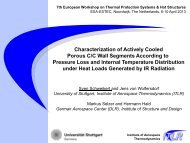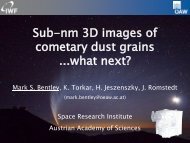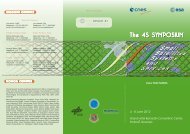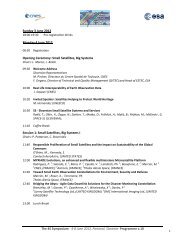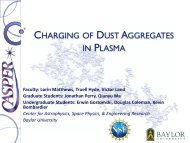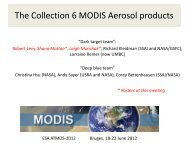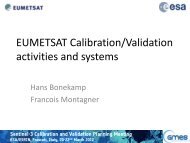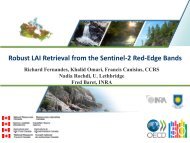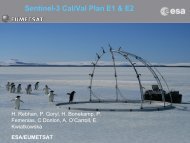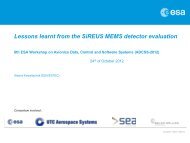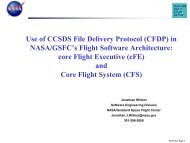10606-landslides-monitoring-zp-etal.pdf
10606-landslides-monitoring-zp-etal.pdf
10606-landslides-monitoring-zp-etal.pdf
Create successful ePaper yourself
Turn your PDF publications into a flip-book with our unique Google optimized e-Paper software.
LANDSLIDE IDENTIFICATION, MOVEMENT MONITORING<br />
AND RISK ASSESSMENT OVER RUGGED MOUNTAIN<br />
AREA USING ADVANCED EARTH OBSERVATION<br />
TECHNIQUES<br />
Project ID: <strong>10606</strong>
<strong>10606</strong><br />
Monitoring <strong>landslides</strong><br />
movement over over rugged<br />
mountain area area integrated<br />
with with multiband SAR SAR and and<br />
LIDAR<br />
Joined proposals<br />
+<br />
10698<br />
Spatio-temporal landslide<br />
identification and and activity<br />
assessment for for hazard<br />
and and risk risk investigations in in<br />
Longnan region,<br />
Northwest China
Institutions:<br />
1.<br />
2.<br />
3.<br />
4.<br />
5.<br />
6.<br />
7.<br />
Team composition<br />
Bai Shibiao Thomas Glade<br />
Liu Guang Zbigniew Perski<br />
Department of Geography and Regional Research<br />
Institute of Geomatics and Analysis of Risk (IGAR)<br />
Polish Geological Institute –National Research Institute ‐Carpathian Branch<br />
Center for Earth Observation and Digital Earth, Chinese Academy of Sciences<br />
Key Laboratory of Virtual Geographic Environment (Nanjing Normal University),<br />
Department of Geomatics, School of Land Science and Technology, China University<br />
China Aero Geophysical Survey & RS Center for Land and Resources
Team composition (2)<br />
• Prof. Michel Jaboyedoff, Institute of Geomatics and Analysis of Risk (IGAR), Switzerland<br />
• Prof. WANG Jian, Key Laboratory of Virtual Geographic Environments, China<br />
• Prof. LV Guonian, Key Laboratory of Virtual Geographic Environments, China<br />
• Prof. HUANG Jiazhu, Key Laboratory of Virtual Geographic Environments, China<br />
• Dr. FAN Jinhui, China Aero Geophysical Survey and RS Center for Land and Resources, China<br />
• Dr. Maria Papathoma‐Koehle, Department of Geography and Regional Research, Austria<br />
• Dr. KANG Zhizhong, Department of Geomatics School of Land Science and Technology, China<br />
University, China<br />
• Dr. Rainer Bell, Department of Geography and Regional Research, Austria<br />
• Dr. YANG Lin, Key Laboratory of Virtual Geographic Environments, China<br />
• Dr. Tomasz Wojciechowski, Polish Geological Institute, National Research Institute ‐<br />
Carpathian Branch, Poland<br />
• Dr. Clement Michoud, Institute of Geomatics and Analysis of Risk (IGAR), Switzerland<br />
• Dr. Marc‐Henri Derron, Institute of Geomatics and Analysis of Risk (IGAR), Switzerland<br />
• Dr. Benni Thiebes, Key Laboratory of Virtual Geographic Environments, National Education<br />
Administration, China<br />
• Young scientists from China and Europe
Objectives<br />
• To utilise a wide range of remote‐sensing<br />
data to detect and map <strong>landslides</strong>, to<br />
assess their activity and velocity,<br />
• To determine the spatial‐temporal variation<br />
of <strong>landslides</strong> and related consequences,<br />
• To apply this in a subsequent hazard and<br />
risk assessment to aid local and regional<br />
decision makers;<br />
• To improve the InSAR technique<br />
towards to<br />
high robustness for <strong>landslides</strong> movement<br />
<strong>monitoring</strong> over rugged mountain area;<br />
Source: geology.enr.state.nc.us
Research areas<br />
Carpathian<br />
Landslides in<br />
Poland<br />
Landslides in Wenchuan<br />
earthquake area (LongMen<br />
Mountain in Sichuan province)<br />
+ Longnan area in South-East<br />
of Gansu province<br />
Three Georges<br />
<strong>landslides</strong><br />
Hubei province
DRAGON 3<br />
Workflow for <strong>landslides</strong> investigations<br />
• Detection<br />
• Characterization<br />
• Monitoring<br />
• Early Warning (Avelar et al 2011)<br />
7<br />
Regional mapping<br />
(inventory, activity)<br />
Site mapping<br />
(geometry, volumes, types,<br />
deformation, …)<br />
Time evolution<br />
Permanent real time<br />
warning system
1.<br />
Workflow for <strong>landslides</strong> investigations<br />
Detection of instabilities<br />
– Methods:<br />
Airborne Laser Scanning<br />
INSAR (PS, SBAS,…)<br />
�Regional mapping<br />
�State of activity of <strong>landslides</strong><br />
Main challenges:<br />
• Increase the detection ability of InSAR<br />
compared to classical inventories<br />
8<br />
Landslide inventory based on ALS<br />
Zbyszyce landslide (Poland)
Workflow for <strong>landslides</strong> investigations<br />
2. Characterization of instabilities<br />
– Methods: Airborne and Terrestrial<br />
Laser Scanning<br />
INSAR (PS, SBAS,…)<br />
�Site mapping: geometry, type, …<br />
�Types of movement (deformation)<br />
Main challenges:<br />
• Using displacement time series to<br />
define sliding mechanisms<br />
9<br />
Very long range TLS system<br />
Czchow (Poland) 2012
Landslide mapping and inventory<br />
(from ALS data)
Methods<br />
• Conventional differential SAR interferometry (InSAR) with L ,C ,X<br />
bands data<br />
• Multitemporal InSAR methods: PSI SBAS<br />
• Landslide Inventory based on change detection with optical images<br />
including hyperspectral<br />
• Change detection based on alternate polarisation data (ASAR)<br />
• Aiborne and terrestrial laser scanning (ALS and TLS) to obtain detailed<br />
elevation data<br />
Improvements & new developments:<br />
• The improved SAR image coregistration methods suitable for mountain area<br />
including external DEM assisted and based on local optimum criteria<br />
• operational algorithm and methodology for <strong>monitoring</strong> using persistent<br />
scatterers interferometry (PSI) and corner reflector (CR‐InSAR) technique on<br />
time‐series of SAR data<br />
• multi criteria point target select method,<br />
• DEM based network construction method,<br />
• precise CR positionig method and CR peak extracting method,
Data provided by ESA and NRSCC
Other Data<br />
• Maps and previous studies (geology,<br />
hydrogeology, geological engineering<br />
reports)<br />
• Available measurements (geodetic<br />
measurements, data from <strong>monitoring</strong><br />
sensors e.g. inclinometers, piezometers)<br />
• Meteorological data<br />
• LiDAR<br />
data (terrestrial and airborne) for<br />
detailed DEM<br />
• Other satellite data: Terrasar‐X<br />
Reading data from piezometer<br />
and inclinometer Cieszyn<br />
(Poland) 2012
Landslides in China<br />
• In China approximate 2/3 areas are the<br />
mountainous areas<br />
• 56% of Chinese population lived in mountainous<br />
areas
Longnan<br />
2010 Gansu Zhouqu mudslide (Yin, 2010)<br />
+ Wenchuan areas
Longnan<br />
+ Wenchuan areas (2)<br />
← Suoertu landslide<br />
←Xieliupo landslide<br />
Landslides in widely<br />
distributed thick<br />
loess and easy<br />
weather rocks<br />
16
Shuping landslide<br />
Three Georges area
Trihedral + GPS<br />
Three Georges area<br />
trihedral bihedral<br />
Corner Reflectors mounted on Shuping landslide
ASAR Data<br />
Three Georges area<br />
3m Desc<br />
1m Desc<br />
1m Asc<br />
TerraSAR‐X Data:<br />
StripMap<br />
Spotlight descending<br />
Spotlight ascending<br />
Data processing: China Aero Geophysical Survey and RS Center<br />
for Land and Resources
Landslides in Carpathians<br />
Location of <strong>landslides</strong> according to the prelliminary recordong<br />
1968 – 2000. (Polish Geological Institute – Carpathian Branch<br />
•65% of all <strong>landslides</strong> in Poland are located in Carpathians<br />
(6% of the territory)<br />
•Total number of lanslides:<br />
> 23.0000<br />
•Average landslide density:<br />
1 landslide / 1 sq. km
Klodne landslide
Aerial photo 2006<br />
Aerial photo 02.07.2010 r<br />
Klodne landslide<br />
HORIZONTAL DISPLACEMENTS
Klodne landslide<br />
SAR interferometry with TerraSAR-X (StripMap)<br />
Full phase cycle equals to LoS<br />
displacement of 15.5 mm
Miedzybrodzie landslide<br />
Envisat ASAR desc + asc PS & SBAS
Expected results<br />
• The creation of detailed multi‐temporal landslide inventory maps which<br />
describe landslide distribution, process types and their state of activity for<br />
the test areas.<br />
• An attempt to creation of local and regional landslide susceptibility,<br />
hazard, vulnerability, risk maps and management strategies<br />
• Forecasts of future landslide risks with respect to Global Change (and<br />
land‐use changes)<br />
• Improved SAR image coregistration algorithm will be designed and<br />
implemented, this will solve the problem of conventional polynomial<br />
method<br />
• Baseline re‐estimation algorithm based ground GCPs, this will improve the<br />
surface land movement accuracy<br />
• Multi‐criteria stable point select method and LiDAR DEM based network<br />
construction method<br />
• Corner reflectors InSAR data processing flow
Thanks for your<br />
attention!<br />
Presentation prepaired by:<br />
Liu Guang<br />
Zbigniew Perski<br />
Mark-Henri Derron<br />
Shibiao Bai




